 |
 |
 |
 |
 |
 |
The further Subete ga F ni Naru goes down the rabbit hole, the better I like it.
The more anime I watch – especially given the broader creative trends in the medium – the more I realize that strangeness is a good thing in and of itself. That’s not to say being strange is enough to make a series good by any means, but absent any other factors it’s a quality I’ve come to appreciate greatly. That’s why a show like Concrete Revolutio interests me despite its myriad flaws – at least it isn’t predictable. Most anime has become way, way too predictable in order to try and fit itself inside increasingly narrow creative boxes, and predictable is something anime should never be. I grew to love anime because of its ability to surprise and even befuddle, because of the creative freedom that seemed to seep from every pore of the medium.
Subete, of course, has the virtue of being both strange and really good. It’s spinning a mystery that in itself is far above the level of most anime puzzlers (this season has no shortage of those), yet that mystery isn’t even the most compelling part of the show for me. I love the atmosphere here, the voice work and the cinematography and the creepy tone. This is a series that’s obsessed with technology, yet the source material was written quite a long time ago now – a vision of what a futuristic lab in 2015 might look like to someone writing almost two decades earlier. That dichotomy casts an odd shadow over the series, making its quirkiness that much more fascinating.
The sense of immersion for me is such that this episode seemed to whiz by in about 10 minutes. This is in many ways a very traditional mystery, with many very traditional elements – a locked-room murder, a bunch of people trapped together with no way to contact the outside world. Heck, all we’re missing is a thunderstorm. Yet as entertaining as that side of the story is, it’s merely the veneer – a vehicle for Mori Hiroshi (and now Ono Toshiya) to explore some of the stranger aspects of modern technology and the darker corners of the human psyche.
The murder of the lab director certainly adds a complicating element to the mystery. The problem here is that everything Yamane and the others are relying on as fact is dependent on the reliability of Deborah and the Red Magic OS. The things he sees as impossible – no one entering of leaving Shiki-sensei’s rooms, no one opening the door to escape the roof after killing the director – are only impossible if the monitoring systems inside the lab are reliable. We (and Saikawa) know, of course, that they’re not – and one way or another, that makes Shiki herself the prime suspect here.
Not even that is as straightforward as it seems, however. Shiki Magata had (or has) some form of multiple personality disorder, and indeed has had since her affair with Saikawa-sensei (or the lab director?) began. When the others finally break down and enter her compound (less worried now about the killer still being inside, for obvious reasons) they find metal shavings on a drill, balloons, and teddy bears. Most interesting are the messages they find on Shiki’s computer (along with the new version of Red Magic) – notes from at least three of her personalities, including the message “Everything becomes F”. And a strange little robot named Michiru who can lock and unlock the door, but not open it.
The fact that Shiki claimed a doll killed her parents seems important, especially given the prominent role robots are playing in the current chain of events. But I’m not ready to put all those pieces together yet, nor to explain away Moe’s muttered “purple – very important…” comment. Still it’s clear she and Saikawa-sensei are the two smartest people in the room now that Shiki is gone (I’m not ready to say “dead”). Moe is enjoying puzzling through this mystery despite an understandable tinge of panic – it’s a chance to play with her crush and to show everyone how smart she is. But the sense is that Saikawa already knows more than he’s letting on, and that these developments are taking him to places (largely in his memory) he would rather not go…
 |
 |
 |
 |
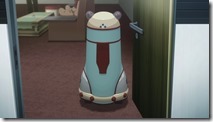 |
 |
 |
 |
 |
 |
 |
 |
 |
 |
 |
 |
 |
 |
 |
 |
 |
 |
 |
 |


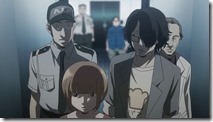


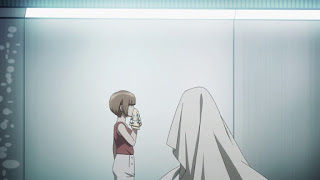

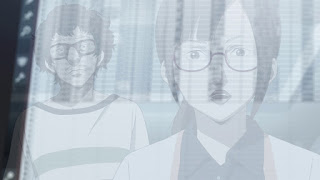
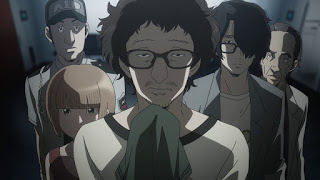


Simone
October 30, 2015 at 9:57 amMy favourite scene of the episode has to be the shower flashback. There is something exceptionally creepy in a 13 years old girl amiably chatting with her multiple personalities, trying to get some courage for her first sexual experience (with an adult man to boot). As you said, weird: one of those things that would be fairly hard to explain out of context.
Alex
October 30, 2015 at 10:54 amI was under the assumption that the man in the flashbacks was the director and not Saikawa-sensei but I could be mistaken?
Altritter
October 30, 2015 at 10:36 pmI'm not sure if the man in the flashbacks is the director (IIRC he didn't have any speaking lines in the present before he died) but it definitely isn't Saikawa. His voice actor is Shunsuke Sakuya, who is also the narrator.
Doug Napoleone
October 31, 2015 at 8:05 pmUm, but there is someone in the room still. How come people have not noticed where they are hiding? I sooo hope my theory is right. They are right there in plain sight! Been there all the time. Just sitting there.
melodic thoughts
November 2, 2015 at 10:06 amIt is neither Saikawa or the director (they look a bit different and this show does make an effort to distinguish its characters' faces).
About multiple personalities, I have always thought that when one personality takes over the mind, the other would not be conscious. However, in Magata's case it seems that Magata is always the one who has control over her body (as witnessed from the bathroom scene) and she is able to converse with her other personalities at will. In that case, her multiple personalities would have been more like "invisible friends" talking to her inside her head. If so, she would be aware of everything that has happened.